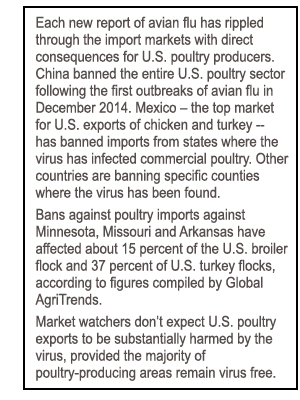The recent avian flu outbreak in the Mississippi migratory flyway has heightened the need for poultry producers to be proactive in protecting their flocks. This is the time for producers to ask:
- Do I have an appropriate biosecurity plan in place?
- Do all my employees know and follow the plan?
 The U.S. Department of Agriculture and Departments of Agriculture in affected states have taken a number of steps to try to contain the spread of multiple strains of avian flu, including quarantines in areas where flocks have been infected. We are encouraging our poultry customers to build their own defenses by working with their veterinarians to tailor biosecurity to their operation.
The U.S. Department of Agriculture and Departments of Agriculture in affected states have taken a number of steps to try to contain the spread of multiple strains of avian flu, including quarantines in areas where flocks have been infected. We are encouraging our poultry customers to build their own defenses by working with their veterinarians to tailor biosecurity to their operation.
The current detected strains of avian flu have been circulating in areas of the United States since late 2014. But these strains arrival in Minnesota, Missouri and Arkansas marks the first time the virus has been detected in the Mississippi flyway for migratory waterfowl. Confirmation of avian flu in a backyard flock of turkeys and ducks in Leavenworth County in eastern Kansas underscores the vulnerability of operations inside or bordering the migratory flyway. Poultry operators in Iowa, Nebraska and South Dakota are all on alert to the potential for H5N2 to spread and cause significant damage to the industry.
These particular strains of avian flu do not harm wild birds and the risk to people is considered low. But in domestic flocks, these strains are devastating as they cause massive internal hemorrhaging in poultry and can kill nearly every bird in an infected flock within 48 hours.
We have been consulting with veterinarians to provide reliable information to poultry producers. Here are some important facts to know about this virus and biosecurity, courtesy of the South Dakota Animal Industry Board:
- Wild waterfowl’s migratory patterns in the fall and spring present an increased risk of transmission of the virus to backyard and commercial poultry.
- A pond or other body of water can attract waterfowl to or near your facility. Consider steps to discourage the use of such ponds by waterfowl.
- Avoid on-farm traffic patterns that cross waterways.
- Provide housing to confine domestic poultry and/or enclose an area with netting.
- Avoid use of water that comes from sources where waterfowl might congregate during migration.
- Waterfowl hunting during migration is best avoided by producers and their employees. Otherwise, ensure clothing, footwear, vehicles, etc. used during hunts are laundered and/or disinfected.
Other biosecurity practices that can reduce the risk of transmission:
- Limit, monitor and record any movement of people, vehicles, or animals on or off your farm.
- Provide disposable coveralls, boots and head coverings for visitors.
- Thoroughly clean and disinfect vehicles and equipment entering or leaving the premises.
- Avoid visits to other poultry operations.
- Prohibit employees from owning or associating with other birds for any purposes.
- Control movement associated with the disposal of mortality, litter and manure.

